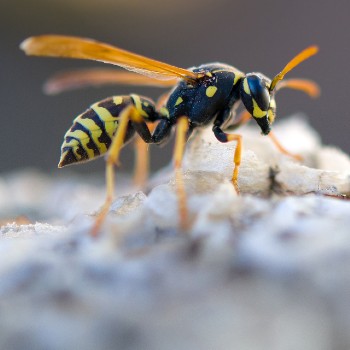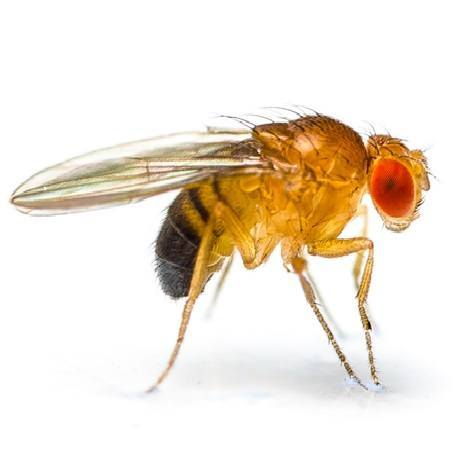Flying Insects - Identification Info & Images
Flying insects can be among the most annoying pests that are found in or around your home, from the buzzing of a common fly to the potential sting of wasps and hornets. No homeowner wants to deal with flying pests. Learn more about the most common types of flying pests and insects that can be found in your home or yard. Of the thousands of insect species that fly, we have selected the most common residential pests.

How to Keep Flying Pests Away
- Keep doors and screen doors closed
- Wipe counters and clean up spills quickly
- Keep food in tightly sealed containers
- Take food trash outside or seal it up
- Hire a local pest control company if needed
- Notify your technician of any pest activity

Types of Flying Insects
AKA: “Umbrella Paper Wasp” or ” Golden Paper Wasp”
General Info: Paper Wasps are not aggressive by nature, but they will sting if they are disturbed or if they feel threatened. Their name comes from the water-resistant, paper-like nests they build from a mixture of plant fibers and saliva.
- Length: 5/8″ – 3/4″
- Region Found: Throughout the United States
- Residential Location: Comb nests are hung from twigs, branches, shrubs, windows, door frames, outdoor grills, eaves, deck floor joists, and more.
- Random/Interesting Fact: Paper wasps have facial recognition abilities comparable to humans and chimps. They know the faces of colony members just as we know the faces of friends and acquaintances!
- Identification: Paper Wasps are brownish with yellow and sometimes red markings. They are long-legged and the hind wing is usually small.
General Info: Hornets are the largest type of wasps. They construct paper-like nests similar to other wasps, but they cover each layer of the nest so that it is completely enclosed except for one entry hole. Hornets have a more painful sting than wasps, but a single sting is only fatal to allergic victims.
- Length: 3/4″ – 1 3/8″
- Region Found: Throughout the United States
- Residential Location: They are found in a variety of areas similar to those of paper wasps.
- Random/Interesting Fact: When hornets sting or are threatened, they emit a pheromone that can mobilize the rest of the colony to attack or defend.
- Identification: These are much bigger than normal wasps. Patterns are black and white, or brown and yellow.
AKA “Mud Wasps”
General Info: Thankfully, mud daubers are not dangerous to humans; they are simply nusiance pests. Mud daubers are solitary wasps. They are not social and do not live in colonies. Mud daubers provision spiders for their larvae by paralyzing them with their venom and bringing them into their nests.
- Length: 1/2″ – 1″
- Region Found: Throughout the United States
- Residential Location: They usually build their nests in a sheltered site. These sites include under eaves, porch ceilings, in garages and sheds left open, in barns, and attics. Nests are short, mud tubes that are constructed side by side.
- Random/Interesting Fact: Other wasps and some spiders will lay eggs in a dauber’s nest.
- Identification:You can easily identify a mud dauber based on the large distance between the abdomen and the midsection. They are usually black. They may have pale markings or a metallic luster.
General Info: These are just a nuisance. You will most likely see them in your kitchen, especially flying around fruits and vegetables. There are many simple fixes to fruit flies. Learn more about the best fruit fly traps.
- Length: 1/8″
- Region Found: Throughout the United States
- Residential Location: They can be found anywhere food is produced or kept.
- Random/Interesting Fact:Fruit flies feed on decaying matter. An example is fruit that has been left out for a few days.
- Identification: They have a tan/light abdomen.
General Info:It gets its name from being the most common fly found in homes. They usually live between 15 and 25 days. Indoors, they rest on floors, walls and ceilings. Night resting places are close to food sources.
- Length: 1/8″ – 1/4″
- Region Found: Throughout the United States
- Residential Location: Found around trash cans, rotten foods, and pet waste.
- Random/Interesting Fact: They are only able to feed on liquids, but they have the ability to turn many solid foods into a liquid form to eat.
- Identification: They are dark gray and have a small, oval-shaped abdomen.
General Info:These are commonly mistaken as bumblebees. Carpenter Bees are solitary bees that burrow into wood for their nests. They prefer wood that is at least 2 inches thick and not painted. There are seven species found in the United States. Adult bees hibernate over the winter and emerge in the spring to feed on nectar.
Use a thick coat of paint or sealant to make carpenter bees less likely to destroy the wood on your property.
- Length: 1/2″ – 1″
- Region Found: Throughout the United States
- Residential Location: Usually can be found borrowing into any wood around the outside of a house.
- Random/Interesting Fact: Carpenter bees actually don’t eat wood. They just excavate it to form their rests.
- Identification: They are yellow or black, and are oval and robust in shape.
General Info:Mosquitoes are most active around dusk and dawn. They hunt for food by detecting body heat and carbon dioxide. Unfortunately, mosquitoes bites not only itch and hurt, they can bring viruses and pathogens to the bite recipient.
- Wear insect repellant and remove any standing water you can find. Mosquitoes can breed in a puddle of water held in a toy in the yard.
- Length: 1/4″ – 3/8″
- Region Found: Throughout the United States
- Residential Location: Mosquitoes can breed in any form of stagnant water ponds, marshes, flood waters, storm drains, and tree stumps.
- Random/Interesting Fact: Only female mosquitoes suck human blood. Males feed on plant nectar.
- Identification: They are narrow and oval in shape. They can be iridescent blue, brown, or green in color.
Insight Pest Solutions offers Mosquito Reduction treatments on a monthly basis to decrease mosquito populations for any of our customers.

